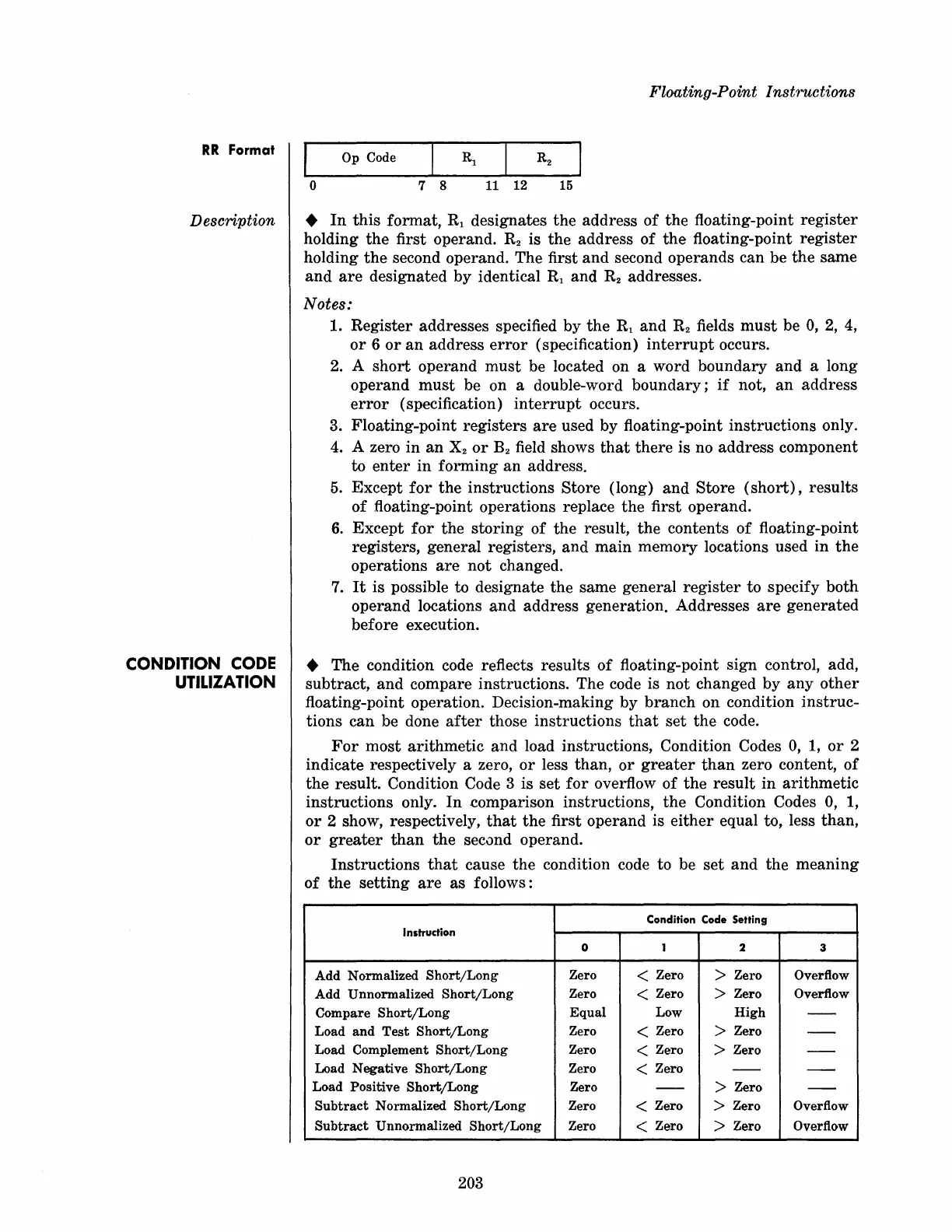RR
Format
Description
CONDITION
CODE
UTILIZATION
Floating-Point Instructions
o
7 8 11 12 15
•
In
this
format, Rl designates
the
address
of
the
floating-point
register
holding
the
first operand.
R2
is
the
address
of
the
floating-point
register
holding
the
second operand. The first
and
second operands can be
the
same
and
are
designated
by
identical Rl
and
R2
addresses.
Notes:
1.
Register
addresses specified
by
the
Rl
and
R2
fields
must
be
0,
2, 4,
or
6
or
an
address
error
(specification)
interrupt
occurs.
2. A
short
operand
must
be located on a word
boundary
and
a long
operand
must
be on a double-word
boundary;
if
not,
an
address
error
(specification)
interrupt
occurs.
3. Floating-point
registers
are
used
by
floating-point instructions only.
4. A zero
in
an
X
2
or
B2
field shows
that
there
is no
address
component
to
enter
in
forming
an
address.
5.
Except
for
the
instructions
Store
(long)
and
Store
(short),
results
of
floating-point operations replace
the
first operand.
6.
Except
for
the
storing
of
the
result,
the
contents
of
floating-point
registers, general registers,
and
main
memory locations used in
the
operations
are
not
changed.
7.
It
is possible to designate
the
same general
register
to specify
both
operand locations
and
address generation. Addresses
are
generated
before execution.
• The condition code reflects results
of
floating-point sign control, add,
subtract,
and
compare instructions. The code is
not
changed by
any
other
floating-point operation. Decision-making
by
branch
on condition
instruc-
tions can be done
after
those instructions
that
set
the
code.
For
most
arithmetic
and
load instructions, Condition Codes
0,
1,
or
2
indicate respectively a zero,
or
less
than,
or
greater
than
zero content,
of
the
result. Condition Code 3 is
set
for
overflow
of
the
result
in
arithmetic
instructions
only.
In
-comparison instructions,
the
Condition Codes 0, 1,
or
2 show, respectively,
that
the
first operand is
either
equal to, less
than,
or
greater
than
the
second operand.
Instructions
that
cause
the
condition code to be
set
and
the
meaning
of
the
setting
are
as
follows:
Condition Code Setting
Instruction
0
1 2
3
Add Normalized
Short/Long
Zero
< Zero > Zero
Overflow
Add Unnormalized
Short/Long
Zero
< Zero
> Zero
Overflow
Compare
Short/Long
Equal
Low
High
--
Load
and
Test
Short/Long
Zero
< Zero
> Zero
--
Load Complement
Short/Long
Zero
< Zero > Zero
--
Load Negative
Short/Long
Zero
< Zero
--
--
Load Positive
Short/Long
Zero
--
> Zero
--
Subtract
Normalized
Short/Long
Zero
< Zero > Zero
Overflow
Subtract
Unnormalized
Short/Long
Zero
< Zero > Zero
Overflow
203

